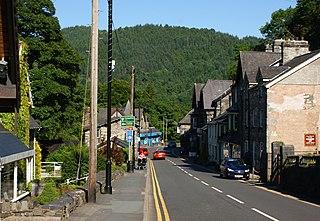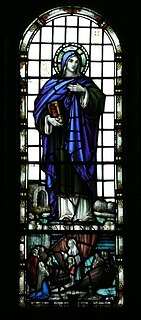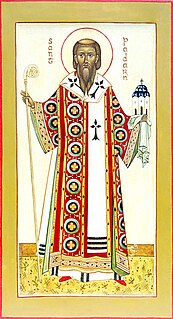Maelgwn Gwynedd was king of Gwynedd during the early 6th century. Surviving records suggest he held a pre-eminent position among the Brythonic kings in Wales and their allies in the "Old North" along the Scottish coast. Maelgwn was a generous supporter of Christianity, funding the foundation of churches throughout Wales and even far beyond the bounds of his own kingdom. Nonetheless, his principal legacy today is the scathing account of his behavior recorded in De excidio et conquestu Britanniae by Gildas, who considered Maelgwn a usurper and reprobate. The son of Cadwallon Lawhir and great grandson of Cunedda, Maelgwn was buried on Ynys Seiriol, off the eastern tip of Anglesey, having died of the "yellow plague"; quite probably the arrival of Justinian's Plague in Britain.
Taliesin was an early Brittonic poet of Sub-Roman Britain whose work has possibly survived in a Middle Welsh manuscript, the Book of Taliesin. Taliesin was a renowned bard who is believed to have sung at the courts of at least three kings.

Betws-y-coed ; English: prayer house in the wood) is a village and community in the Conwy valley in Conwy County Borough, Wales, located in the historic county of Caernarfonshire, right on the boundary with Denbighshire, in the Gwydir Forest. It is now a very popular visitor destination in the Snowdonia National Park.

Capel Curig is a village and community in the historic county of Caernarfonshire, currently administered as part of the unitary authority of Conwy County Borough, in Wales. It lies in the heart of Snowdonia, on the River Llugwy, and has a population of 226, reducing slightly to 206 at the 2011 census. It lies at the junction of the A5 road from Bangor and Bethesda to Betws-y-Coed with the A4086 road from Caernarfon, Llanberis, Pen-y-Pass and Pen-y-Gwryd. It is surrounded by hills and mountains, including Moel Siabod and Pen Llithrig y Wrach.

Brychan Brycheiniog was a legendary 5th-century king of Brycheiniog in Mid Wales.
Maelgwn ap Rhys was prince of part of the kingdom of Deheubarth in south west Wales.

Llangurig is both a village and a community in Montgomeryshire, Powys, Wales. The population was 723 in the 2011 UK Census. The community includes the hamlet of Cwmbelan.

Saint Cybi or Saint Cuby was a 6th-century Cornish bishop, saint and, briefly, king, who worked largely in North Wales: his biography is recorded in two slightly variant medieval 'lives'.

Dyffryn Mymbyr is a valley in Snowdonia, in north-west Wales, approximately 5 miles (8.0 km) in length, and leading up from Capel Curig to the Pen-y-Gwryd hotel.

Non was, according to Christian tradition, the mother of Saint David, the patron saint of Wales.

Saint Padarn's Church is a parish church of the Church in Wales, and the largest mediaeval church in mid-Wales.

Padarn was an early 6th century sanctified British Christian abbot-bishop who founded St Padarn's Church in Ceredigion, Wales. The first bishop of Braga and Saint Paternus of Avranches in Normandy appear to be the same person. Padarn built a monastery in Vannes and is considered one of the seven founding saints of Brittany. Padarn's early vita is one of five insular and two Breton saints' lives that mention King Arthur independently of Geoffrey of Monmouth's Historia Regum Britanniae.
Brynley Francis Roberts, known as Bryn Roberts, is a Welsh scholar and critic, who has written much on the Welsh language and Celtic history. He was Professor of Welsh Language and Literature at the University of Wales, Swansea 1978–1985 and Librarian of the National Library of Wales in 1985–1994, then made editor of the Dictionary of Welsh Biography in 1987 and of Y Traethodydd in 1999. He is on the council of the Honourable Society of Cymmrodorion and involved in the Morfa Chapel, Aberystwyth, part of the Presbyterian Church of Wales.

Eglwys y Bedd is all that remains of a 14th-century church in Anglesey, north Wales. It is set within the churchyard of St Cybi's, Holyhead, and may have been built on the site where Cybi lived and ministered. It is reputed to house the grave of Seregri, an Irish warrior who lived in the area in the 5th century.

Capel Colman is a parish in northeast Pembrokeshire, Wales, in the community of Boncath. Formerly in the Hundred of Cilgerran, Capel Colman is a small, rural parish of some 750 acres (300 ha) surrounded by the larger parishes of Cilgerran, Manordeifi, Clydau, Penrydd and Llanfihangel Penbedw. The parish is in the Manordeifi group in the Church in Wales Diocese of St David's.
Eisteddfa Gurig is a hamlet located in Ceredigion on its border with Powys and situated along the A44. Its name comes from the Welsh word eisteddfa, meaning seat and the name of St Curig. This gives the meaning of Curig's seat. It is said that Curig rested on the hill here and looked down into the Wye Valley. He decided to build a church in the valley, which is still there today in the village of Llangurig.
Kathy Louise Jones is a Welsh Anglican priest and chaplain. From January 2016 to June 2021, she was Dean of Bangor making her one of the most senior priests in the Church in Wales. Previously, she was the Lead Chaplain of the Northumbria Healthcare NHS Foundation Trust in the Diocese of Newcastle, Church of England.
Saint Tydecho was a 6th century saint of Wales.
Clydwyn is a 6th century Pre-Congregational Saint of Wales.











